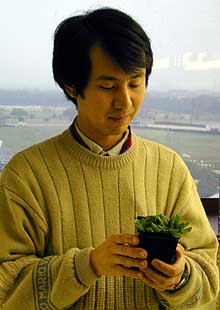Mutants from a lowly weed may solve maladies

Dr. Hisashi Koiwa, Texas Agricultural Experiment Station horticulturist, examines an Arabidopsis plant in his lab at Texas A&M University. Mutants of the plant, a common weed, may help scientists find answers to a wide variety of maladies s from salt stress in plants to HIV in humans. (TAES photo by Kathleen Phillips)
Mutants from a lowly weed. That’s where many solutions to maladies – from salt stress in plants to HIV in humans – may lie in wait for scientists to discover.
“I look for mutants. I take a sick plant and find out what’s wrong,” said Dr. Hisashi Koiwa, Texas Agricultural Experiment Station horticulturist.
It’s the Arabidopsis plant, a common weed, that attracts Koiwa and other researchers because of its simple genetic makeup. Scientists have looked at every nook and cranny of the weed’s DNA code.
The order of those code sequences known as A, C, T and G is what makes a human genetically both different from and similar to, say, the Arabidopsis, Koiwa noted. Because the Arabidopsis code sequence is known, he said, researchers are beginning to understand how particular genes work within the segments.
That’s where mutants help. Researchers can simply “knock out” a particular portion of the Arabidopsis, then grow the mutated plant to see how it reacts to various conditions compared to “normal” Arabidopsis plants.
In Koiwa’s case, the condition of choice is salt stress.
High salt levels are found in one third of the world’s cropland and that means reduced yields, according to a report by Purdue University. Before coming to Texas A&M University in 2002, Koiwa was part of a Purdue team that discovered the gene and protein, known by scientists as AtCPLs and AtHKT1. AtCPLs tune plant gene expression under stressful environments, and AtHKT1 allows salt to enter plants.
Until the AtHKT1 discovery, no one knew how sodium gets into plants, Purdue reported.
With that information and wide collaboration, Koiwa hopes to steer continued work in his Texas lab around a mutant Arabidopsis plant which is much more sensitive to salt.
“With Arabidopsis, we know that there is a mechanism to ’pump out’ salt from a cell, or move it from a critical part to a less critical part,” Koiwa said. “We need to understand more about the molecular reasons the plant is sensitive to salt than its osmosis, or ability to move salt around.”
Koiwa’s current focus is natural ability of two different Arabidopsis varieties to move around salt which “may answer many questions as to why some crops are more salt sensitive than others,” he said.
And similar work may yield answers from plants for HIV research in humans, Koiwa added.
He said mutant studies have revealed genes of four “CTD phosphatase-like regulators (or AtCPLs)” in plants, whereas humans have only one.
Targeting CTD, in humans, is a proposed defense mechanism to prevent HIV from making its parts, thus multiplying itself, he explained.
Koiwa already has located two Arabidopsis mutants for AtCPL genes, and different behavior of the two mutants implies that each have different functions.
“So we have to ask, why does a plant have four and a human only one,” he said. “There must be a reason, and there must be a reason that the additional regulators behave differently.”
He said future research may lead to transferring the phenomena in plants in vitro or in transgenic plants to see if any of the four plant CTDs are more sensitive or more resistant to the HIV protein known as TAT.
Writer: Kathleen Phillips, (979) 845-2872,ka-phillips@tamu.edu
Contact: Hisashi Koiwa, (979) 845-5341,koiwa@neo.tamu.edu
Media Contact
More Information:
http://agnews.tamu.edu/dailynews/stories/HORT/Mar0303a.htmAll latest news from the category: Life Sciences and Chemistry
Articles and reports from the Life Sciences and chemistry area deal with applied and basic research into modern biology, chemistry and human medicine.
Valuable information can be found on a range of life sciences fields including bacteriology, biochemistry, bionics, bioinformatics, biophysics, biotechnology, genetics, geobotany, human biology, marine biology, microbiology, molecular biology, cellular biology, zoology, bioinorganic chemistry, microchemistry and environmental chemistry.
Newest articles

First-of-its-kind study uses remote sensing to monitor plastic debris in rivers and lakes
Remote sensing creates a cost-effective solution to monitoring plastic pollution. A first-of-its-kind study from researchers at the University of Minnesota Twin Cities shows how remote sensing can help monitor and…

Laser-based artificial neuron mimics nerve cell functions at lightning speed
With a processing speed a billion times faster than nature, chip-based laser neuron could help advance AI tasks such as pattern recognition and sequence prediction. Researchers have developed a laser-based…

Optimising the processing of plastic waste
Just one look in the yellow bin reveals a colourful jumble of different types of plastic. However, the purer and more uniform plastic waste is, the easier it is to…



